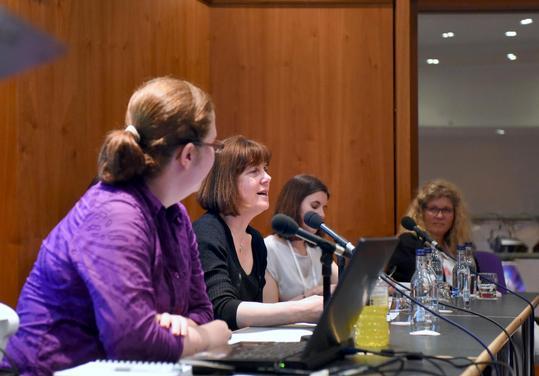Patient Box - The power of networks: a workshop on good clinical practice in the context of European Reference Networks

At the occasion of its Membership Meeting held on the 26th of May 2016 in Edinburgh and in the framework of the RARE-Bestpractices project, EURORDIS organised a workshop on: “Good clinical practice in the context of European Reference Networks”. The annual EURORDIS Membership meeting gathers about 200 participants, mainly leaders of European patient organisations, but also some researchers, health professionals, policy makers and industry representatives.
Powerful tools for European Reference Networks
The workshop was moderated by Geske Wehr (a patient representative of the organisation Selbsthilfe Ichthyose e.V., Germany) and Juliette Senecat (project manager at EURORDIS).
Domenica Taruscio (Istituto Superiore di Sanità, Italy, RARE-Bestpractices project leader) set the scene by placing the subject of best practice guidelines in the context of rare disease European Reference Networks (ERNs). Then, the team of Healthcare Improvement Scotland (represented by Karen Ritchie, Jenny Harbour and Lorna Thompson) introduced the tools developed by the RARE-Bestpractices project to collect best practices guidelines and research recommendations as well as the methodology to appraise clinical guidelines for rare diseases.
Patient engagement: “Nothing about us without us”
In the second part of the workshop, two patient representatives presented case studies highlighting the contribution of the rare disease patient community in the identification, appraisal and dissemination of best practice guidelines for rare diseases and in the promotion of their use in the context of ERNs. Avril Kennan (DEBRA Ireland) described “the power of networks in clinical practice guideline development”, showing how DEBRA is developing international guidelines for epidermolysis bullosa and how ERNs have a huge potential in facilitating the development of clinical guidelines for rare diseases. Then, Silvia Van Breukelen (VSOP – Dutch patient alliance for rare and genetic diseases) developed the example of patient involvement in the development of rare disease standards of care in the Netherlands. These are initiated and developed by patient organisations in close cooperation with healthcare providers (following the slogan: “Nothing about us without us”).
The workshop ended with a lively discussion on principles for the engagement of people living with a rare disease in translational activities, led by the team of Healthcare Improvement Scotland.
Participants discussed the updating of guidelines, which is a major challenge. Guidelines should be updated in a pragmatic way, by updating only the fields that really need an update when there is new evidence and republishing only when there is a major change in the guidelines. Conflicts of interest are also a major issue that patients need to watch carefully. It was also highlighted that guidelines need to be developed in a systematic way, with a clear process to review the evidence (clinical trials but also many other sources) and to come up to a recommendation. Even if there is a lack of evidence, it was stressed that rare diseases guidelines need to be developed as strictly as guidelines for common conditions in terms of quality. A peer review process before publication is key to ensure the robustness of the guideline. Participants highlighted the following principles for engaging patients in translational activities: awareness of patient experience, mutual trust and equal voice. Even if involving patients in guidelines’ development is a strong recommendation by experts, this is too often missed.
The programme of the EURORDIS Membership Meeting 2016 and all the presentations are available under the following link: http://www.eurordis.org/content/membership-meetings.
Juliette Senecat, Mathieu Boudes
EURORDIS European Organisation for Rare Diseases